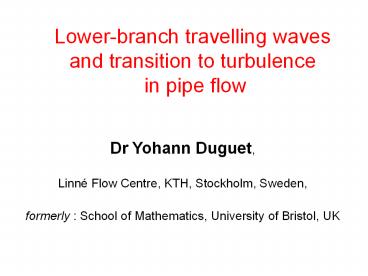Exact recurrent states in the transition to turbulence in pipe
Title:
Exact recurrent states in the transition to turbulence in pipe
Description:
Title: Exact recurrent states in the transition to turbulence in pipe Last modified by: Philipp Schlatter Document presentation format: Bildschirmpr sentation –
Number of Views:99
Avg rating:3.0/5.0
Title: Exact recurrent states in the transition to turbulence in pipe
1
Lower-branch travelling waves and transition to
turbulence in pipe flow
Dr Yohann Duguet, Linné Flow Centre, KTH,
Stockholm, Sweden, formerly School of
Mathematics, University of Bristol, UK
2
Overview
- Laminar/turbulent boundary in pipe flow
- Identification of finite-amplitude solutions
along edge trajectories - Generalisation to longer computational domains
- Implications on the transition scenario
3
Colleagues, University of Bristol, UK
- Rich Kerswell
- Ashley Willis
- Chris Pringle
4
Cylindrical pipe flow
U bulk velocity
s
D
z
L
Driving force fixed mass flux The laminar
flow is stable to infinitesimal disturbances
5
Incompressible N.S. equations
Numerical DNS code developed by A.P. Willis
Additional boundary conditions for numerics
6
Parameters
Re 2875, L 5D, m01 (Schneider et. Al.,
2007)
Numerical resolution
(30,15,15) ? O(105) d. o. f.
Initial conditions for the bisection method
Axial average
7
Edge trajectories
8
Local Velocity field
9
Measure of recurrences?
10
Function ri(t)
11
Function ri(t)
rmin(t)
12
rmin along the edge trajectory
13
Starting guesses
A
B
rmin O(10-1)
14
Convergence using a Newton-Krylov algorithm
rmin O(10-11)
15
The skeleton of the dynamics on the edge
Recurrent visits to a Travelling Wave solution
16
A solution with only at least two unstable
eigenvectors remains a saddle point on the
laminar-turbulent boundary
Eu
Es
Eu
17
A solution with only one unstable eigenvector
should be a local attractor on the
laminar-turbulent boundary
Eu
Es
Es
18
Imposing symmetries can simplify the dynamics
and show new solutions
L 2.5D, Re2400, m02
19
Local attractors on the edge
C3 (Duguet et. al., 2008, JFM 2008)
2b_1.25 (Kerswell Tutty, 2007)
20
TURBULENCE
B
A
C
LAMINAR FLOW
21
Longer periodic domains
2.5D model of Willis L 50D, (35, 256, 2,
m03) ? generate edge trajectory
22
Edge trajectory for Re10,000
23
Edge trajectory for Re10,000
24
A localised Travelling Wave Solution ?
25
(No Transcript)
26
Dynamical interpretation of slugs ?
Extended turbulence
Slug trajectory?
localised TW
relaminarising trajectory
27
Conclusions
- The laminar-turbulent boundary seems to be
structured around a network of exact solutions - Method to identify the most relevant exact
coherent states in subcritical systems the TWs
visited near criticality - Symmetry subspaces help to identify more new
solutions (see Chris Pringles talk) - Method seems applicable to tackle transition in
real flows (implying localised structures)































